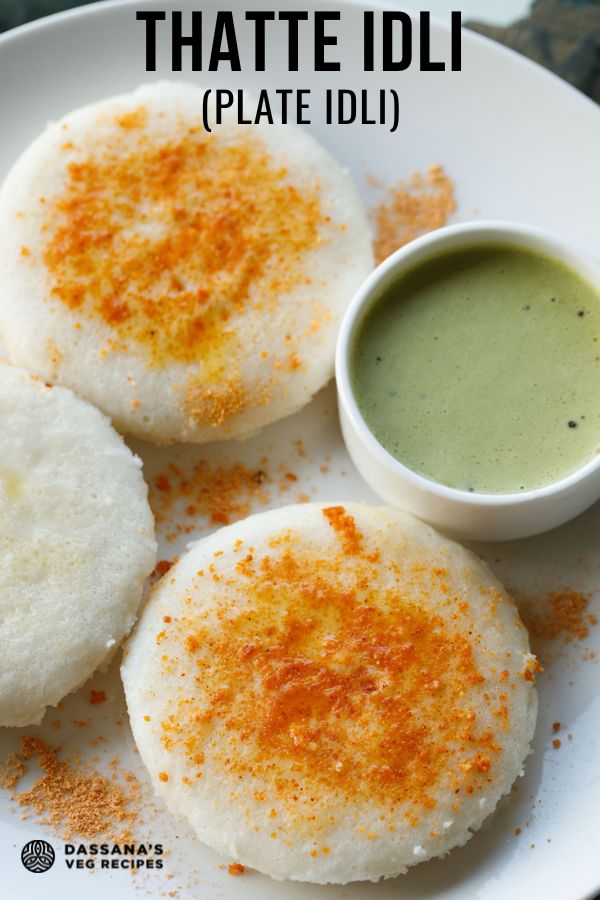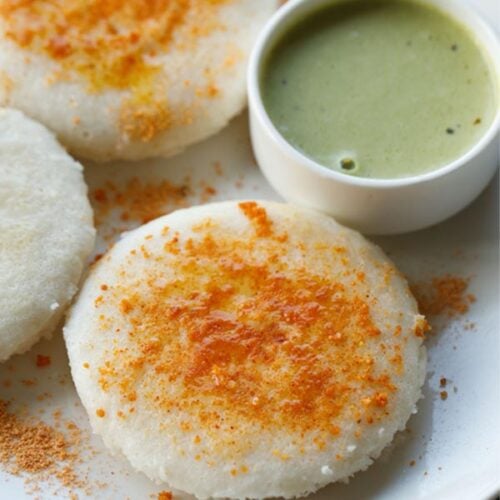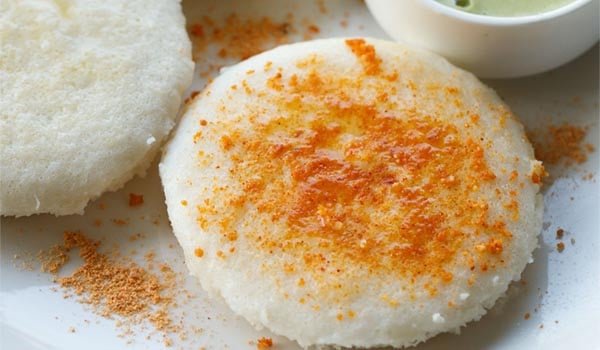The favored South Indian snack Idli is a kind of dishes, which is normally tender and fluffy in its texture. However what if I say that there’s one other variant, particularly from Karnataka, which is softer, fluffier and lighter? Sure, it’s the Thatte Idli that’s extremely tender and porous like a cloud! Additionally recognized regionally because the Plate Idli, it has been a private favourite too, since fairly a while. On this submit, I share my recipe, which, after you strive, will make you actually thank me. Go for it!

About Thatte Idli
‘Thatte’ refers to a ‘plate’ in Kannada language. Therefore, Thatte Idli or Plate Idli is a definite kind of idli from the southern state of Karnataka, notably from areas like Tumkur and Bidadi close to Bangalore.
In contrast to the normal, small, and fluffy idlis discovered throughout South India, Tatte Idli is bigger, flatter, and steamed in shallow plates or spherical trays as an alternative of the small moulds sometimes used for normal idlis.
Thatte Idli or Tatte Idli’s origins are attributed to native small-scale eateries that served staff and vacationers alongside the highways.
These roadside stalls wanted a fast but hearty meal that might enchantment to everybody, and the bigger, plate-shaped idlis match the invoice completely.
Plate Idli is believed to have been first launched by enterprising cooks trying to serve a filling, simply shareable model of the idli that may very well be served shortly.
Its bigger dimension and distinctive texture helped it achieve recognition amongst truck drivers and long-distance vacationers who frequented freeway eateries.
Utilizing the plates would additionally guarantee fewer utensils and fast cleanups for a lot of of those eateries and eating places.
At this time, Thatte Idli is loved not simply in Karnataka however throughout South India, celebrated for its distinctive style, dimension, and satisfying texture, making it a much-loved model of the traditional idli.
Why Thatte Idli is tremendous tender?
A really well-known road meals as effectively, the batter of Tatte Idli is completely different from the batter of the common Idli.
Together with the same old idli rice and break up black gram (urad dal), puffed rice or flattened rice (poha) and typically sago (sabudana) are additionally added, which make these idlis extremely tender and cloud-like. Having stated this, additionally it is doable to make common idli with the batter of Plate Idli.
About My Recipe
In my recipe of Thatte Idli, I take advantage of each thick poha and sabudana which make these idlis tremendous tender and light-weight. You possibly can substitute the poha with puffed rice, if most well-liked.
The method is just like making ready an idli batter – you’ll have to soak, grind the components, and ferment the batter. Afterward, steam it in plates.
I make Tatte idli on particular events, and this is among the finest recipes you may strive. This methodology is particularly useful for those who don’t have a Plate Idli stand or steamer.
Simply use small-rimmed plates and steam the idlis in a pan or pot. With my detailed directions beneath, you’ll be capable to make tender, spongy Thatte Idli simply at dwelling.
Tatte Idli or Plate Idli is historically served with coconut chutney and a spicy sambar, with a dollop of butter or ghee and some sprinklings of idli podi, typically added for additional taste.
Should you love making an attempt varied forms of idli, you too can take a look at my recipes of Ragi Idli, Kanchipuram Idli, Oats Idli and Millet Idli.
Step-by-Step Information
Learn how to make Thatte Idli
Soak Components
1. In a bowl, take ¾ cup (150 grams) entire skinless black gram (urad dal) and ¼ teaspoon fenugreek seeds (methi seeds).

2. Rinse with water a couple of occasions. Soak the lentils and fenugreek seeds in 1 cup water for five hours.

3. In one other bowl, take 2 cups (400 grams) idli rice and ½ cup (40 grams) thick flattened rice (thick poha).

4. Rinse once more with water, for a few occasions. Then, soak in 2½ cups water for five hours.

5. Equally, take ¼ cup (40 grams) sago/sabudana in a small bowl.

6. Once more, rinse with water and soak in ½ to 1 cup of water for five hours.

Make Batter
7. Earlier than grinding these soaked components, drain all of the water from them and hold apart.
In a mixer-grinder or a table-top moist grinder, take the lentils, fenugreek seeds and sago collectively.

8. Add 1 cup water and grind to a positive consistency. The batter should have no granular consistency, and must be positive and easy.
Switch this batter to a big bowl or pot.

9. In the identical grinder, add a portion of soaked idli rice and thick flattened rice. Add some water and grind to a positive, grainy consistency.

10. Identical approach, grind the idli rice and thick flattened rice in batches of 1 to three. You’ll need so as to add a complete of 1 cup water in parts, whereas grinding in batches.
Be certain that the rice batter just isn’t very skinny or thick.

11. Pour the rice batter into the identical bowl containing the lentil batter. Add 1 teaspoon edible rock salt or in response to style.
Bear in mind to not make the thatte idli batter too thick. Go for a medium-thick and flowing batter.

Ferment Batter
12. Combine the edible rock salt completely with a spoon or spatula. Use pink salt or sea salt instead of rock salt, for those who wouldn’t have it.
Cowl the bowl/pan with a lid and permit the batter to ferment for 8 to 9 hours or till the batter will increase in quantity and doubles or triples.

13. The batter may also have a pleasant fermented aroma and loads of air-pockets.
Word: If fermented effectively, no want so as to add baking soda. If not, then add ¼ to ⅓ teaspoon. I didn’t add baking soda.

Steam Thatte Idli
14. Grease oil or ghee evenly on small plates measuring 3 to six inches or the particular idli plates that you simply get available in the market to make this thatte idli variant.
Pour the ready batter overlaying ¾ᵗʰ of the plates.

15. Take a big kadai (wok) or a big pan that may accommodate all the three or 4 plates. Add 2 to three cups water relying on the scale of the kadai or pan. Place a trivet. Let the water start to simmer gently.
You’ll have to steam these 3 or 4 plates in batches within the pan or pot. If in case you have the specialised Thatte Idli plates, then use these plates and the stand that comes with these.
You can too use a dhokla stand or shallow bowls. Should you used the Thatte Idli plates & stand, then use an idli steamer to steam.

16. Scale back warmth and gently and punctiliously place the plates with the batter on the trivet.

17. Improve the warmth to medium or medium-high.
Cowl the kadai or pan with a lid and steam for 15 to twenty minutes or till the plate idlis are agency to the touch. A toothpick or fork inserted ought to come out clear.

18. Fastidiously take away the plates with tongs, as they are going to nonetheless be sizzling. Relaxation for five minutes after which, gently take away plate idli with a water moistened spoon or butter knife.
Place on serving plate and unfold some ghee on high. Sprinkle with Idli Podi and unfold on the idlis.
Serve Thatte Idli sizzling with Coconut Chutney and/or Sambar.

Skilled Ideas
- Rice Alternate options: Should you don’t have idli rice, you may substitute with common rice like sona masuri, surti kolam or parmal.
- Baking Soda: If the batter hasn’t fermented correctly, add round ¼ to ⅓ teaspoon of baking soda to assist obtain a tender texture.
- Ingredient Substitutions: You should use puffed rice (murmura) instead of poha, and omit the fenugreek seeds if wanted. Sabudana may be ignored, however word that the idlis will likely be a bit much less tender with out it. All different components are needed.
- Fermentation: Be sure that the batter ferments absolutely. A well-fermented batter will double or triple in quantity, develop a nice bitter aroma, and present many small air bubbles.
- In Colder Climates: Fermentation could take longer in chilly situations. To hurry up the method, hold the batter in a heat spot, corresponding to close to a heater or in an oven with the sunshine on.
- Gear: Historically, these idlis are made in particular Thatte Idli plates, which you will discover on Amazon. Should you don’t have this typical stand, use small rimmed plates, shallow bowls, or a dhokla stand. This batter additionally works effectively for making common idlis, leading to a tender, spongy texture.
FAQs
It’s known as Tatte Idli as a result of it’s steamed in a large, flat plate, referred to as ‘tatte or thatte’ in Kannada, giving it a bigger and flatter form than common idlis.
Plate Idli is bigger, flatter, and extra fluffier, whereas common idlis are smaller, softer, and steamed in spherical moulds.
Sure, Thatte Idli batter is fermented, which helps create its tender and barely tangy taste.
Tatte Idli originated in Karnataka and have become widespread at roadside eateries, particularly alongside highways, the place its bigger dimension made it a filling meal for vacationers.
Sure, Plate Idli is nutritious, being a great supply of carbohydrates, protein, and fiber from each the rice and lentils, and it’s simply digestible attributable to fermentation.
Extra Karnataka Particular Breakfasts To Attempt!
Please you’ll want to charge the recipe within the recipe card or depart a remark beneath you probably have made it. For extra vegetarian inspirations, Signal Up for my emails or comply with me on Instagram, Youtube, Fb, Pinterest or Twitter.

Thatte Idli | Plate Idli
If there’s an idli variant softer and fluffier than the common idli, it’s the Karnataka particular Thatte Idli or Tatte Idli or Plate Idli. Do this recipe to know. It’s known as corresponding to it’s steamed in a plate, referred to as ‘thatte’ in Kannada, giving it a bigger and flatter form than common idlis.
Prep Time 10 minutes
Cook dinner Time 20 minutes
Soaking Time 5 hours
Whole Time 5 hours 30 minutes
Stop your display from going darkish whereas making the recipe
Soaking Components & Making Batter
In a bowl take the urad dal and fenugreek seeds.
Rinse with water a couple of occasions. Soak the urad lentils and fenugreek seeds in water for five hours.
In one other bowl take idli rice and thick poha (flattened rice).
Rinse once more with water for a few occasions after which soak in water for five hours.
Equally take the sabudana (sago) in a small bowl.
Once more rinse with water. Soak the sabudana in water for five hours.
Earlier than grinding these soaked components, drain all of the water from them and put aside.
In a mixer-grinder or a table-top moist grinder, first take the urad dal, fenugreek seeds and sabudana collectively.
Add 1 cup water and grind to a positive consistency. The batter should have no granular consistency however must be positive and easy.
Switch this batter to a big bowl or pot.
In the identical grinder, add a portion of soaked rice and poha. Add some water and grind to a positive grainy consistency.
Identical approach, grind rice and poha in batches of 1 to three. You’ll need so as to add a complete of 1 cup water in parts whereas grinding in batches.
Bear in mind to not make the rice batter thick or skinny.
Pour the rice batter into the identical bowl containing the urad dal batter. Add the edible rock salt or in response to style.
- Combine very effectively. The batter ought to have a medium-thick flowing consistency. Therefore, add the identical quantity of water as talked about within the recipe, except you employ a unique number of rice or aged lentils.
Cowl bowl/pan with a lid and permit the batter to ferment for 8 to 9 hours or as wanted till the batter will increase in quantity and doubles or triples.
After a great fermentation, the batter may also have a pleasant fermented bitter aroma and loads of air-pockets.
Making Thatte Idli
Grease oil or ghee evenly on small plates measuring 3 to six inches or the particular idli plates that you simply get available in the market.
Pour batter overlaying ¾ of the plate.
Take a big kadai (wok) or a big pan that may accommodate all the three or 4 plates.
- You’ll have to steam 3 to 4 plates at a time utilizing a big pot or pan. If in case you have the specialised thatte idli plates, then use the stand that comes with these.If in case you have used the thatte idli stand, steam the idlis in an idli steamer.
In kadai or pan, add 2 to three cups relying on its dimension, depth and quantity.
Place a trivet. Let the water start to softly simmer.
Scale back warmth. Gently and punctiliously place the plates on the trivet.
- Improve the warmth to medium or medium-high. Cowl kadai or pan with lid and steam for 15 to twenty minutes or as required till the idli are agency to the touch. A toothpick or fork inserted ought to come out clear.
Fastidiously take away the plates with the assistance of tongs, as they are going to nonetheless be sizzling.
Relaxation for five minutes. Gently take away the thatte idli with water moistened spoon or butter knife.
Place the Plate Idlis on a serving plate. Unfold some ghee on every plate idli. Sprinkle every plate idli with idli podi and unfold it with a spoon.
Serve Thatte Idli sizzling or heat with coconut chutney. You can too serve with sambar.
- If the batter has not fermented effectively, contemplate including ¼ to ⅓ teaspoon of baking soda.
- Purpose for a medium thick batter with flowing consistency. Add water as talked about within the recipe, whereas grinding the components.
- If in case you have used some other number of rice or aged lentils, you’ll have to modify the amount of water when grinding rice and the lentils.
- Thick batter will yield denser idlis and a skinny batter will make them too tender and overly moist that they received’t maintain form.
- Should you reside in chilly locations, permit the batter to ferment for some extra time.
- You would skip the ghee sprinkling and go for sesame oil as an alternative. The idli podi can be given a miss.
Vitamin Details
Thatte Idli | Plate Idli
Quantity Per Serving
Energy 423 Energy from Fats 72
% Each day Worth*
Fats 8g12%
Saturated Fats 1g6%
Polyunsaturated Fats 0.4g
Monounsaturated Fats 6g
Sodium 8mg0%
Potassium 77mg2%
Carbohydrates 80g27%
Fiber 3g13%
Sugar 0.01g0%
Protein 7g14%
Vitamin A 8IU0%
Vitamin B1 (Thiamine) 1mg67%
Vitamin B2 (Riboflavin) 0.1mg6%
Vitamin B3 (Niacin) 4mg20%
Vitamin B6 0.2mg10%
Vitamin B12 0.01µg0%
Vitamin C 0.1mg0%
Vitamin D 0.01µg0%
Vitamin E 3mg20%
Vitamin Okay 0.4µg0%
Calcium 7mg1%
Vitamin B9 (Folate) 233µg58%
Iron 4mg22%
Magnesium 24mg6%
Phosphorus 96mg10%
Zinc 1mg7%
* % Each day Values are primarily based on a 2000 calorie eating regimen.


